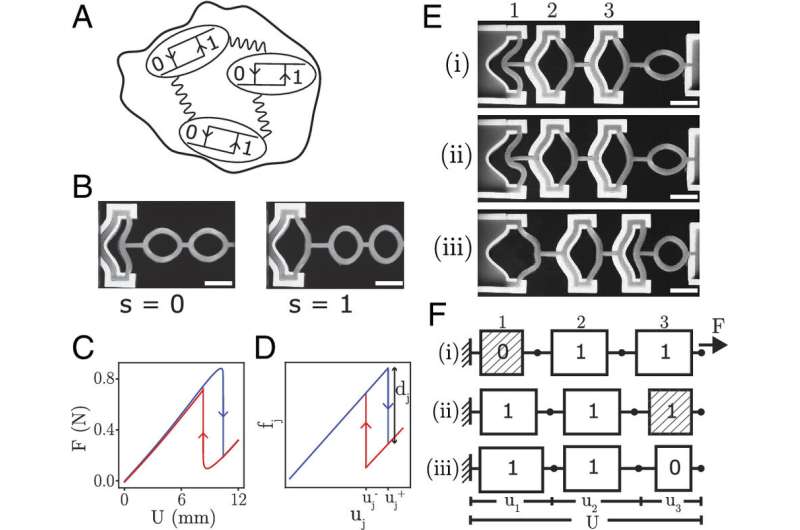This article has been reviewed according to Science X's editorial process and policies. Editors have highlighted the following attributes while ensuring the content's credibility:
fact-checked
peer-reviewed publication
trusted source
proofread
Researchers use 'smart' rubber structures to carry out computational tasks

Without electronics carrying out computational tasks, our daily lives would look very different. Devices such as elevators, vending machines, turnstiles, washing machines and even traffic lights use a simple form of electronic computing to switch from state to state. But, what if a power supply is not available to operate these devices?
A research team led by Martin van Hecke from Leiden University and AMOLF has now demonstrated how smart rubber structures can carry out such computational tasks. "We now know how to design simple materials so they can process information."
The study was published in the Proceedings of the National Academy of Sciences on May 20.
In electronics, digital bits are used to perform calculations, involving complex circuits consisting of many elements. The researchers have found an alternative strategy to compute, using slender rubber elements as mechanical bits, and assembling multiple bits together in a "metamaterial." But to get these materials to work as machines, they found that the key is to control the interactions between these individual bits.
A binary counter
As a first example, the research team created a rubber computer that can act as a two-bit binary counter—as demonstrated in the accompanying movie, whereby stretching the metamaterial makes it count from "00" to "11", and back to "00" by releasing it.
The team employs pre-curved rubber beams as mechanical bits, mediating the interactions by connecting them. Information can thus be stored and processed. Counting is an important example of a simple so-called finite state machine, and this rubber device can, for instance, be used to control the motion of the legs of a simple robot.
Turnstiles and combination locks
"A significant experimental breakthrough occurred in the last month before my return to China during the pandemic," says researcher Jingran Liu, who at the time was a visiting Ph.D. student at Leiden University and AMOLF and is now a postdoc in Madrid. "We suddenly realized how to design a more complex three-bit system, and within a few days, we had made four working samples."
The researchers quickly realized that such three-bit metamaterials were far more powerful than the two-bit predecessors. "Depending on how these samples are manipulated, they can perform seventeen different simple calculations," explains AMOLF postdoc Lishuai Jin.
For example, the metamaterials could replicate the functionality of a turnstile. "A turnstile manages entry with its rotating arms—locking and unlocking in response to the insertion of coins and the push from customers. Our metamaterials can emulate this mechanism through a specific sequence of states and driving pulses," says Jin. Moreover, the rubber computer can also be used for a combination lock or vending machine, and much more.
"Our work shows that complex computations can be performed by smart metamaterials, in a manner that is completely different from traditional computing," says Liu. "What I find very exciting is that our principles are not limited to mechanics. Moreover, complex memory effects, that are important in physics but difficult to study, can now be used for something extremely useful: efficient computing."
More information: Jingran Liu et al, Controlled pathways and sequential information processing in serially coupled mechanical hysterons, Proceedings of the National Academy of Sciences (2024). DOI: 10.1073/pnas.2308414121


















